
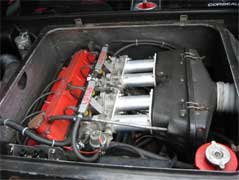
Giugiaro Fuel Injection
Conversion
Electronic Fuel Injection Conversion of
912 Low Compression Engine
by Andy Hills
During the rebuild of my 1981 S3 in 2003 a number of modifications were made to the engine including new cams, flowed head, tubular exhaust manifold etc and the jetting of the original Delortto DHLA 45 carbs no longer matched the fuelling requirement of the engine. I decided not get the carbs re-jetted but instead to replace them with an electronic fuel injection system as this will potentially give better power, economy, lower emissions for MOT tests and allow any further modifications to the engine to be easily tuned.
A number of ECU systems are available with some costing over £2K, however the controller I went for was a low cost DIY system called MegaSquirt. This is a build and fit yourself ECU which costs approx £100 and is tuned via a laptop using free software called MegaTune. Only the ECU is provided, the software is a free download and everything else you have to source yourself.
The basic list of parts required for a covversion is :-
ECU (MegaSquirt)
Throttle Bodies
Injectors
Fuel Pressure Regulator
Fuel rails
Inlet Manifold Pressure Sensor
Temperature Sensors
High Pressure Fuel Pump
Exhaust Oxygen Sensor
However, the list of parts needed for the Esprit did not stop there. The old carbs have float chambers, which store a supply of fuel when the tank level gets low, but an EFI system does not have this. When the fuel tank level is low the fuel can move to the edge of the tanks during cornering and uncover the fuel pump pickups. This allows the fuel pump to suck up air and this is feed to the fuel injectors, which causes the air/fuel mixture to go dangerously lean and lead to holed pistons.
To get around the problem most cars have baffling in the fuel tank or a unit called a swirl pot fitted. A swirl pot is basically a second smaller tank, which holds fuel around the pickup when the tank level gets low. However the S3 has no baffling or swirl pot in the fuel tanks, so a surge tank had to fit a into the fuel system, which is just an external swirl pot.
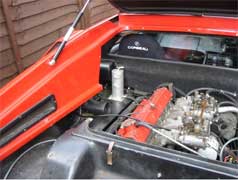
Unfortunately having an external surge tang also requires a second fuel pump. The drawing below shows how the fuel supply system is assembled.
Excess fuel from the swirl tank needs to be returned to the main fuel tanks and this was done by tapping into the tank filler vent pipes.
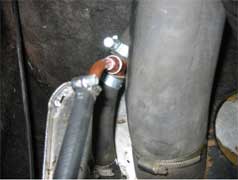
The main mechanical components of any fuel injection system are the throttle bodies and I managed to obtain a set of throttle assemblies from a late model 4 cylinder Esprit, however all of the cable linkage was missing which needed fabricating.
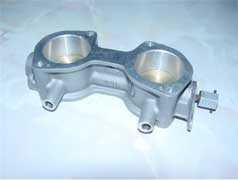
Also the mounting holes for the new throttle bodies are different to the DLHA45s. To overcome this problem the inlet manifold had to have all the mounting holes aluminium welded over and new mounts drilled and tapped. This would prevent refitting of the old carbs (if required) so a second 912 inlet manifold was obtained and the modifications were made to this casting. Another problem was where to mount the electronic fuel injectors, as there is no room available on the throttle bodies. Luckily there are convenient flat castings on the manifold on each runner, these were drilled out to 14mm for the Bosch injectors. To supply the injectors, a set of fuel rails need to be fabricated from alloy bar. This was then mounted to the inlet manifold together with the fuel pressure regulator.
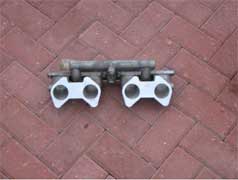
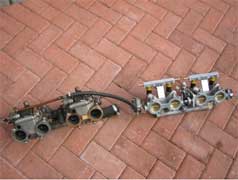
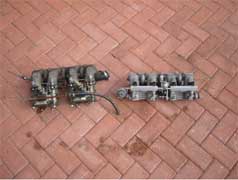
As no throttle linkages were supplied with the trottle bodies these needed to be made from scratch. The linkage now also has a stepper motor to provide cold start fast idle.
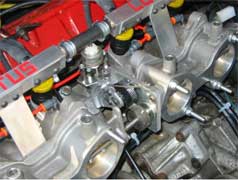
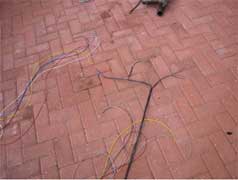

Once the inlet manifold and throttle body modification were complete and the fuel system in place, the old manifold and carbs were removed and the new system fitted. A wiring loom was then fabricated to connect up all the electronic components (fuel injectors, temperature sensors, throttle position sensor, fuel pumps etc) to the ECU, which is mounted above the nearside furl tank along side the surge tank.
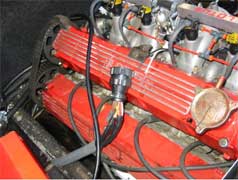
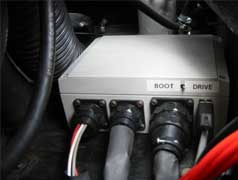
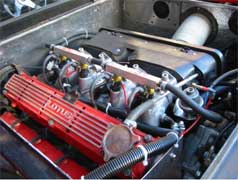
The ECU was connected to the wiring loom using sealed automotive connectors to allow hardware changes to be made easily.
With all the components now fitted all that remained was to tune the ECU to the engine’s characteristics.
This is done using a laptop loaded with the free Megatune software. The basic parameters are entered (number of cylinders, throttle type, injector flow rate etc) and a basic fuelling map is entered.
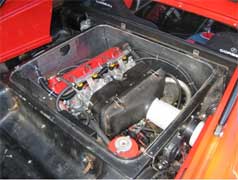

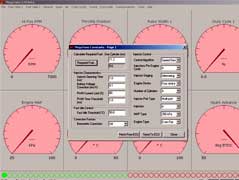
From this base map the engine’s air/fuel ratio is measured and logged on a laptop using an oxygen sensor mounted in the exhaust manifold and is adjusted until the engine is at the desired performance.
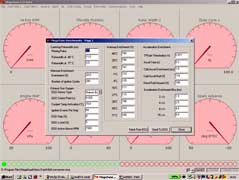
During the initial tuning process it was found that the engine was not performing as expected. This was tracked down to the length of the inlet tract being too short due the reduced length of the new throttle bodies compared with the old carbs. To rectify this error, inlet extensions were constructed from 6mm alloy plate and 44mm ID tubing.
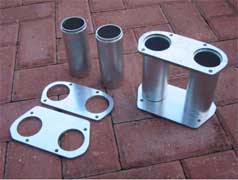
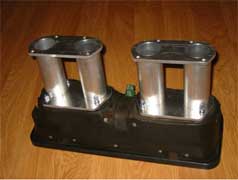
The extensions were inserted in between the air box and the throttle bodies as this position required the least amount of changes to the components already fitted.
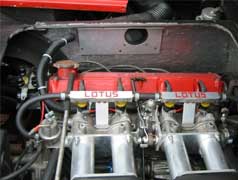

With the new inlet extensions fitted the engine performed much better and allowed the tuning process to continue. The engine is now running very well on the EFI system (certainly much better than with the old carbs) with improved economy and emissions. Making alterations to the engine can now be maximised as the fuelling can be altered to make the most of the improvements.
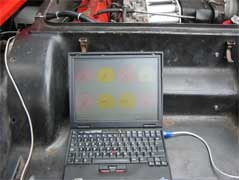
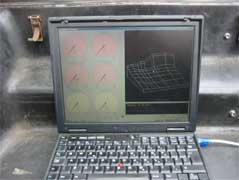
The MegaSquirt ECU can also be used to provide 3D mapped ignition control using a Ford EDIS ignition module, coil pack and crankshaft position sensor. This replaces the fixed vacuum mechanical distributor/Luminition ignition unit and provides better drivability and performance at low throttle openings. The EDIS module also has multi spark capability at low engine speeds to improve the smoothness of the engine at idle. The EDIS module operates on the “wasted spark” principal in that 2 spark plugs are fired together, one on the ignition stroke (eg cylinder 1) as usual and one on the exhaust stroke (eg cylinder 4). As all the fuel has been burnt before the exhaust stroke the extra fired spark has nothing to ignite and is hence “wasted”. Using this method reduces the number of coils need, eliminates the distributor and also reduces the number of sensors needed.
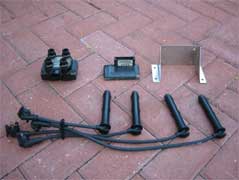
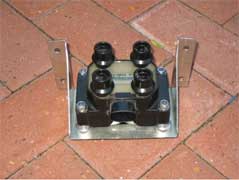

To allow correct ignition timing to be obtained, a crankshaft position is used to indicate when the pistons are at the top of their travel. This is done by fitting a 36-1 trigger wheel to the front crankshaft pulley and a magnetic sensor to the front crank seal housing.
This crankshaft position sensor is interrogated by EDIS module, which fires the appropriate ignition coil. The coil pack is mounted on the end of the cam towers to keep the ignition leads as short as possible.
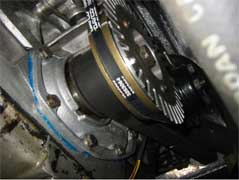
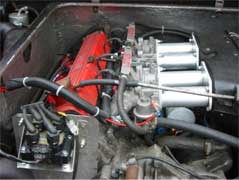

The EDIS receives information about the required spark advance from the MegaSquirt ECU. The amount of advance is held in a 3D map (similar to the fuel map) within the MegaSquirt ECU and is calculated using RPM and inlet manifold pressure data.
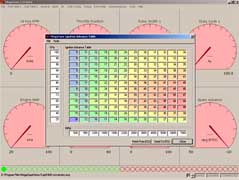

In case of a communication failure the EDIS module has a limp home mode providing a fixed 10¾ of ignition advance.
The ECU also provide other functions such as hard and soft rev limiters, shift lights, launch control, cooling fan control etc.Verdict
by Andy HillsThis conversion was not simple and took over a year to complete. The amount of mechanical fabrication required was quite high due to the low cost components selected, but I like a challenge. The total cost of the conversion has been less than £1000 excluding labour but that did include purchasing a number of duplicate parts to allow the car to be returned to the old carbs and distributor at a later date. The conversion can be done more easily by using DHLA throttle body kits from Jenvey or Webcon, (which includes fuel rails and linkages), but this increases the cost significantly.
Even though the conversion has taken over a year, I feel it was well worth the effort. With all of these modifications the Esprit becomes a much more pleasant car to drive with many of the drawbacks of the 1970/1980 engine control technology improved. The car is producing more power (dyno run to be done shortly), no longer suffers from hot starting problems and the major cause of engine fires (carbs leaking fuel onto the distributor) has been eliminated. Also the extra functions provided by the ECU (such as launch control) are well worth having.
For more information on the MegaSquirt Fuel Injection system visit: -
www.megasquirt.info
www.msefi.com
This mod was performed by Andy Hills on his 1981 S3
If you have any comments, feel free to e-mail LEW at admin@lotusespritworld.com
I converted my '82 turbo to EFI 2 years ago and it has been running happily ever since. I used Jenvey throttle bodies which are a physical match for the existing dellortos and an ECU from DTA (www.dtafast.co.uk) to control everything. This arrangement keeps all the air plumbing and increased power from 210bhp to 240bhp without increasing boost or fitting a chargecooler.
David Loomes
|
|